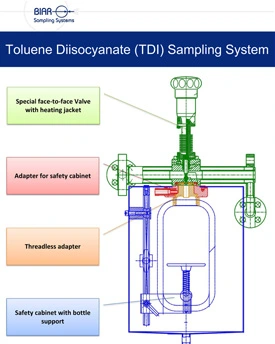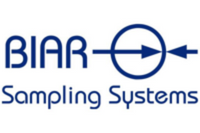SAMPLING TOLUENE DIISOCYANATE (TDI)
Keeping Toluene Diisocyanate in a Liquid State
Toluene Diisocyanate (TDI) is used to manufacture foams, adhesives, sealants, coatings and elastomers. Although it has a low toxicity, the Occupational Safety and Health Administration (OSHA) has established limits on allowable TDI vapor concentrations in work environments.
Why It's Important to Take TDI Samples
- To ensure proper temperatures for processing (can go above 300°C (572°F)
- To prevent solidification at ambient temperatures
What to Look for in the Sample
- Fluidity
- Vapor Concentration
How to Safely Take TDI Samples
- Multi-function stainless steel Inline Sample Valve with spring-to-close function
- Thread adapter or bottle support
- Heating Jacket
- Safety Cabinet (vented)
- Safety Plug (for secondary containment)

Benefits of system components include:
- Safety Cabinet minimizes operator’s exposure to TDI fumes
- Valve Heating Jacket maintains TDI at process temperature
- Multi-Function Valve allows adapter to be quickly removed for cleaning purposes after each use (no special tools required)
- Operator has direct access to the stainless steel nipple for cleaning (adapter doesn’t need to be removed)
Toluene Diisocyanate
1) Description
Name: ..............................................................................................Toluene Diisocyanate
Chemical Formula: .....................................................................CH₃C₆H₃(NCO)₂
CAS No: ..........................................................................................584-84-9
Other Names: ...............................................................................TDI, 2,4-TDI, 2,4-Toluene diisocyanate
Uses: ...............................................................................................Industrial
Physical state: ..............................................................................Solid or liquid (above 71°F)
Color: ..............................................................................................Colorless to pale-yellow solid or liquid (above 71°F)
Odor: ...............................................................................................Strong, Pungent
Boiling Point: ................................................................................251°C (484°F)
Melting Point:.................................................................................21°C (71°F)
Flash Point: ....................................................................................126°C (260°F)
Flammability (solid, gas): ..........................................................LEL 0.9% UEL 9.5%
Vapor Pressure:.............................................................................(77°F): 0.01 mmHg
2) Hazards
Immediately Dangerous to Life or Health Concentrations (IDLH) (NIOSH)
Class IIIB Combustible Liquid: Fl.P. at or above 200°F.
This material is considered hazardous by the OSHA Hazard Communication Standard. The current OSHA permissible exposure limit (PEL) for TDI is 0.005 ppm as an 8-hour time- weighted average (TWA) concentration and as a ceiling concentration of 0.02 ppm.
H317: (100%): May cause an allergic skin reaction
H318: (36.18%): Causes serious eye damage
H319: (63.82%): Causes serious eye irritation
H330: (100%): Fatal if inhaled
H334: (100%): May cause allergy or asthma symptoms or breathing difficulties if inhaled
H335: (99.84%): May cause respiratory irritation
H351: (100%): Suspected of causing cancer
H412: (95.32%): Harmful to aquatic life with long lasting effects
Reactivity: Strong oxidizers, water, acids, bases & amines (may cause foam & spatter); alcohols [Note: Reacts slowly with water to form carbon dioxide and polyureas.]
Specific Hazards related to Sampling: TDI can solidify at ambient temperatures and when sampling, it is usually at high temperatures. Sample systems must incorporate a heating jacket to maintain process temperatures and adequate protection must be part of the design. TDI is not highly toxic but exposure limits have been established by OSHA regarding allowable TDI vapor concentrations in the work environment. Sample systems must be designed to protect the Operators and the environment from vapors.



